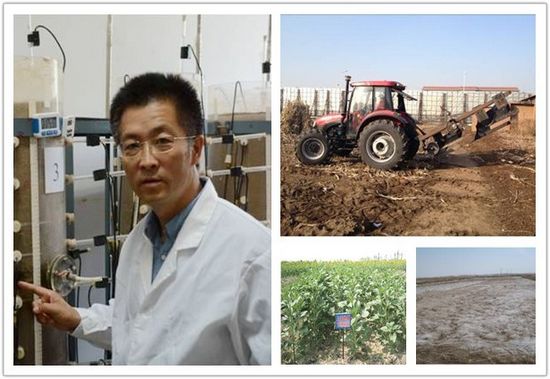分享到
New technologies for saline-alkali soil amelioration and utilization in the Yellow River irrigation areas
Recently, researchers headed by Professor Pang Huancheng at the Institute of Agricultural Resources and Regional Planning (IARRP) of Chinese Academy of Agricultural Sciences (CAAS) has made major breakthrough in key technologies for saline-alkali soil amelioration and utilization in the Yellow River irrigation areas.
According to Professor Pang, in the Yellow River irrigation areas, traditional flood irrigation caused salinity problems frequently and the phenomenon “salt leaching with water” in irrigation period and “salt retention with water evaporation” in non-irrigation period, thus led to surface soil salt accumulation. As the decreasing irrigation water from the Yellow River, traditional flood irrigation had been out of action. Therefore, studying the technology to desalt the topsoil (0-40cm) through the salinity regulation of time, space and morphology is necessary with the consideration of saving water.

According to Professor Pang, in the Yellow River irrigation areas, traditional flood irrigation caused salinity problems frequently and the phenomenon “salt leaching with water” in irrigation period and “salt retention with water evaporation” in non-irrigation period, thus led to surface soil salt accumulation. As the decreasing irrigation water from the Yellow River, traditional flood irrigation had been out of action. Therefore, studying the technology to desalt the topsoil (0-40cm) through the salinity regulation of time, space and morphology is necessary with the consideration of saving water.

Funded by the Special Fund for Agro-scientific Research in the Public Interest, the research team launched systematic research in these areas including Mongolia, Ningxia and Gansu Provinces from 2009. The team broke through the key technical bottleneck and developed the combined technology of plastic film mulch and buried straw layer, which integrates salt controlling, fertility improving and water saving into a whole. Under this technology, salt contents in the topsoil significantly decreased by 10.2%-53.2%, soil organic matter and soil moisture increased by 0.2g/kg-0.3g/kg and 2%-4% respectively. Moreover, average crop yields in medium and severe saline areas increased by 9.8%-14.6% and 26.3%-35.3% respectively.
The research team also invented the machine for deep burying straw layer and developed series of matching products including soil conditioner which significantly reduce the soil pH, nutritional soil modifier applied to new reclaimed salty wasteland. In the meanwhile, the research team formulated 10 local technological standards which were suitable to different saline-alkali soils to help resist salt hazard and increase crop yields. Up to now, total extension area of above mentioned research findings have been amounted to 11540 thousands of acres in these areas.
The research team also invented the machine for deep burying straw layer and developed series of matching products including soil conditioner which significantly reduce the soil pH, nutritional soil modifier applied to new reclaimed salty wasteland. In the meanwhile, the research team formulated 10 local technological standards which were suitable to different saline-alkali soils to help resist salt hazard and increase crop yields. Up to now, total extension area of above mentioned research findings have been amounted to 11540 thousands of acres in these areas.
By Li Yuyi
liyuyi@caas.cn
liyuyi@caas.cn
Latest News
-
 Apr 18, 2024Opening Ceremony of the Training Workshop on Wheat Head Scab Resistance Breeding and Pest Control in Africa Held in CAAS
Apr 18, 2024Opening Ceremony of the Training Workshop on Wheat Head Scab Resistance Breeding and Pest Control in Africa Held in CAAS -
 Apr 03, 2024IPPCAAS Co-organized the Training Workshop on Management and Application of Biopesticides in Nepal
Apr 03, 2024IPPCAAS Co-organized the Training Workshop on Management and Application of Biopesticides in Nepal -
 Mar 28, 2024Delegation from the School of Agriculture and Food Science of University College Dublin, Ireland Visit to IAS, CAAS
Mar 28, 2024Delegation from the School of Agriculture and Food Science of University College Dublin, Ireland Visit to IAS, CAAS -
 Mar 25, 2024Director of World Food Prize Foundation visited GSCAAS
Mar 25, 2024Director of World Food Prize Foundation visited GSCAAS -
 Mar 20, 2024Institute of Crop Sciences (ICS) and Syngenta Group Global Seeds Advance Collaborative Research in the Seed Industry
Mar 20, 2024Institute of Crop Sciences (ICS) and Syngenta Group Global Seeds Advance Collaborative Research in the Seed Industry
